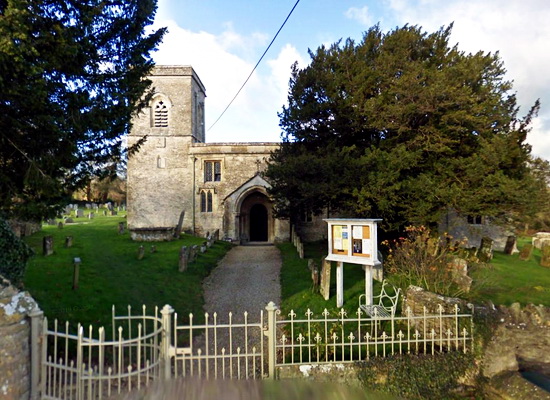St. James the Great
Fulbrook (6)
Fulbrook lies on the A361, half a mile north-east of Burford between Burford and Shipton-under-Wychwood. The village has about 450 residents, 2 pubs, (details below) and no shops. The church is just north of the A361 in the centre of the village, up a narrow lane on the left when approaching from Burford and opposite the war memorial.

Parking is restricted and Church Lane has very little turning space. There is usually space to park near the war memorial. There is a WC in the church, locked unless you have contacted us in advance. There is also a small kitchen and light refreshments may be available for ringers by prior arrangement. The nearest public lavatories are in Burford.
Fulbrook pubs with food available.
The Carpenters Arms, Greene King, tel. 01993823275
Closed Sun. evening and all day Monday.
Burford, with numerous eating places and shops, is 15mins. walk or 4 mins. drive away.
Historical Notes
Fulbrook’s name is thought by some to be derived from the Old English, ‘ful’, meaning ‘muddy’ or ‘foul’, but those of us who live in the village prefer the alternative theory—that the name comes from the fulling process in the wool industry. Fullers earth was readily available locally. Although close to Burford, Fulbrook was always a separate entity, both socially and legally, the manor held by Hugh le Despenser, Earl of Winchester, and his successors from the Norman Conquest until the middle of the 14th.century. It lay at the edge of the great forest of Wychwood, a royal hunting estate from Saxon times, and early Saxon herring-bone stonework can be seen exteriorly in the south wall of the Nave.
The church porch, dating from the late 13th.century, stands before a fine Norman doorway. Scratch dials and a votive cross may be seen in the nearby stonework. The nave and north aisle are linked by an arcade of Transitional pointed arches, supported by stout Norman pillars. Among the roof bosses is a “green man”. On the south wall of the nave is mounted a panel commemorating the 1892 restorations, including work on the bells. The 15th century tower incorporates a 13th.century lancet window, now serving the new ringing chamber above the vestry
Until 2003 the ground-floor ring of 3 included treble and tenor cast in Burford by Edward Neale in 1662 and the 2nd. by Henry Bagley in Witney in 1732. The Sanctus bell, also by Neale, dates from 1649 and is still in use.After 2 years’ fund-raising by the local ringers, a new bell-frame was installed for a ring of 6, including the original tenor and the Bagley bell. The original poor-toned treble now stands in the north aisle of Burford Church, known as the bellfounders’ aisle, beside 2 others from the Neale foundry near a wall-mounted memorial to the founder’s wife.Three new bells were cast at Whitechapel in 2003, the treble, 2nd. and 4th. The 3rd., a former Trinity House buoy bell, came from the Keltek Trust. After construction of the new first-floor ringing chamber, the bells were hung by Whites of Appleton in 2004.
Home Tower Contacts
Tower Contacts  Fulbrook
Fulbrook